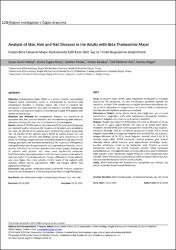Analysis of Skin, Hair and Nail Diseases in the Adults with Beta Thalassemia Major

View/
Date
2018Author
Pektaş, Suzan DemirAlataş, Emine Tuğba
Pektaş, Gökhan
Karakuş, Volkan
Azık, Fatif Mehmet
Doğan, Gürsoy
Metadata
Show full item recordAbstract
Objective: beta-thalassemia major (BTM) is a genetic disorder necessitating frequent blood transfusions, which is characterized by functional and physiological disorders in multiple organs. We aimed to research the prevalence of associated skin, hair, and nail disorders, and their relationship with clinical and laboratory features of the disease in adult BTM patients and healthy control groups. Materials and Methods: We prospectively analyzed the prevalence of associated skin, hair, and nail disorders. We recorded demographic features, laboratory findings skin, hair, and nail disorders in the participants. Results: Atotal of 71 BTM patients (36 males and 35 females) and 50 age and sex matched healthy individuals (36 females and 36 males) were included in the study. 32 (45.1%) of the patients and 3 (4.2%) of the control groups had hair, 26 (36.6%) of the patients and 6 (8.3%) of control groups had nail diseases. The most common skin findings xerosis were determined in 66 (93%), hair findings, telogen effluvium were determined in 16 (22.5%), and nail findings, dystrophic nail were determined 9 (12.7%) in patients. BTM patients had significantly higher fruquent xerosis, scar, pigmentation disorders, nevus, pruritus, infections, nail and hair disorders than control groups. Average age of patients with pruritus and nevus were significantly enhanced. Postinflammatory hyperpigmentation and melanocytic nevus in male patients had more higher than female patients. Telogen effluvium in female patients was more higher than male patients. Ferritin levels of the patients with ephelide, diffuse bronze pigmentation (DBP) and telogen effluim had significantly enhanced. Conclusion: Age, gender, medication history and ferritin level are important factors for the development of dermatological disorders among BTM patients.

















